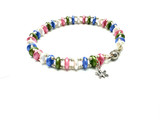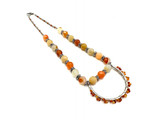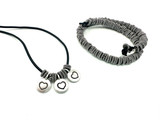Jewelry Safety: Lead Content Classifications
| At Rings & Things, we work hard with manufacturers and testing agencies to ensure that our products meet the requirements of California's lead-in-adult-jewelry law, the most stringent law in the U.S.A. regarding lead content in adult jewelry. Products in our online store are labeled according to the classification chart below. Information on this page covers the basics you need to know to comply with California law. Even if you don't live in California, you might need to follow these guidelines. Do you participate in California arts-&-crafts shows? Do you sell your jewelry, gifts or accessories online and ever ship to California? If you answered yes to either of these, you sell retail to California! The California lead classification system is NOT the same as the CPSIA's Federal children's-jewelry law, but it DOES explain lead content in our products. And, since California maintains the most stringent U.S. laws regarding lead content in adult jewelry components, their guidelines are good to follow for anyone concerned about jewelry safety—no matter where you live or sell your wares. How concerned should I be about lead content? We also comply with California's Proposition 65, which requires the labeling of products that contain lead or other potentially hazardous substances, regardless of how those products are classified for use in jewelry. Many components deemed suitable by California for use in retail jewelry still require Prop. 65 labeling. For example, rhinestone crystals and other leaded-glass parts require a Prop. 65 lead warning label even though they are Class 1 suitable materials under California's "lead in jewelry" law. Many tools also carry the Prop. 65 lead warning because the type of brass or other metals used in machining tools is generally allowed to contain a small % of lead by weight. This doesn't mean that it HAS this much lead -- it just means that it is allowed to, because you generally don't gnaw on your tools. Please keep in mind that none of our components are intended for the creation of children's jewelry, or intended for use by children under the age of thirteen. We've read and heard about too many lawsuits where a jewelry-maker sold children's jewelry that they assumed would be worn by a properly-supervised baby, toddler or small child, and was sued when an unsupervised child choked or strangled on their jewelry. This is tragic -- we are parents, grandparents, aunts, uncles and siblings, and these incidents makes us cry. We sell thousands of tiny items that if not properly assembled, can be choking hazards, or other hazards, so please use caution with children's jewelry whether you are the one making it or putting it on your children. Can the cording or chain get tangled while adults are out of the room? Can small items be broken off and ingested? Even if they don't have lead, they can still be choking hazards. For these reasons, we cannot recommend any of our components for use in children's jewelry. | ||||||||
CA Jewelry-Making Materials Classification: | ||||||||
| ||||||||
| **All gemstones sold by Rings & Things fit in Class 1 and are suitable for retail jewelry sold in California. The following stones are known to be hazardous and do not fit in Class 1: aragonite, bayldonite, boleite, cerussite, crocoite, ekanite, linarite, mimetite, phosgenite, samarskite, vanadinite and wulfenite. These stones are fascinating for various reasons, but absolutely should be not be used in jewelry. | ||||||||
Naturally Lead-Free Metals | ||||||||
The following elements and alloys (mixtures of elements that create a metal) are either lead free or have a very low lead content because, by definition, they are comprised of metals other than lead:
| ||||||||
How concerned should I be about lead content? | ||||||||
Lead (Pb)Lead (PB) is an element used to make alloys (mixtures of metals) softer and to help alloys melt at lower temperatures. The problem with using lead in alloys is that it is toxic when ingested, and can cause serious health problems, especially in children. Because children's bodies are still developing, lead can affect them in ways it is not likely to affect adults. The two main ways lead poses a danger are when it is:
Jewelry components containing lead are generally considered safe for adults to handle and wear externally. Nevertheless, as safety and environmental standards continue to rise, measures are being taken to use lead less, both in jewelry components and in general. Lead oxide (PbO)Lead oxide (PbO) is a compound sometimes used in glassmaking. Advantages to using lead oxide in glass include increased refraction (which creates the beautiful prism effect we associate with glass crystal) and a lower working temperature/viscosity (which makes the glass easier to work with). During vitrification (when powdered ingredients melt under heat to form glass), the lead oxide becomes "trapped" inside the glass and can no longer be easily absorbed. In normal use, the lead in leaded glass does not leach out the way metallic lead can. However, you should not store milk or acidic liquids (such as wine) in lead-crystal decanters for more than a few hours. Want to know more about lead, or lead in jewelry components? |
Our Bead Blog
-
Simply Springy 2-Hole Bracelet
Apr 28th 2025Designed by: Guest Designer Deb Floros Suggested Supplies 1 #61-840-50-01 Beadalon Cord, WildFire,
-
Exotic Statement Necklace
Apr 28th 2025Designed by: Guest Designer Deb Floros Suggested Supplies 1 #88-400-003-5 58x50mm Pewter Connector,
-
Rubber Tubing Necklace and Memory Wire Bracelet Set
Mar 21st 2025Designed by: Guest Designer Deb Floros Suggested Supplies 1 #61-622-02 2mm Rubber Cord, Bulk, for J



